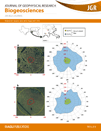The eastern Amazon Basin may become drier as a result of less regional recirculation of water in a largely deforested landscape and because of increased frequency and intensity of El Niño events induced by global warming. Drier conditions may affect several plant and soil microbial processes, including soil emissions of CO2, CH4, NO, and N2O. We report here unanticipated results of a pilot study that was initiated to test the feasibility of a larger-scale throughfall exclusion experiment. In particular, soil drying caused a switch from net consumption of atmospheric CH4 by soils in the control plot to net CH4 emission from soils in the experimentally dried plot. This result is surprising because production of CH4 requires anaerobic microsites, which are uncommon in dry soil. A plausible explanation for increased CH4 emissions in the dried plot is that dry soil conditions favor termite activity and increased coarse root mortality provides them with a substrate. Another surprise was that both NO and N2O fluxes were elevated several years after initiation of the drying experiment. Apparently, a pulse of N availability caused by experimental drying persisted for at least 3 years. As expected, CO2 emissions were lower in the dried plots, which is consistent with lower rates of root growth observed in root in-growth cores placed in the dried plots. More work is needed to test these explanations and to confirm these phenomena, but these results demonstrate that changes in climate could have unanticipated effects on biogeochemical processes in soils that we do not adequately understand.
DOI:
https://doi.org/10.1007/s00374-002-0517-x
Altmetric score:
Dimensions Citation Count:























